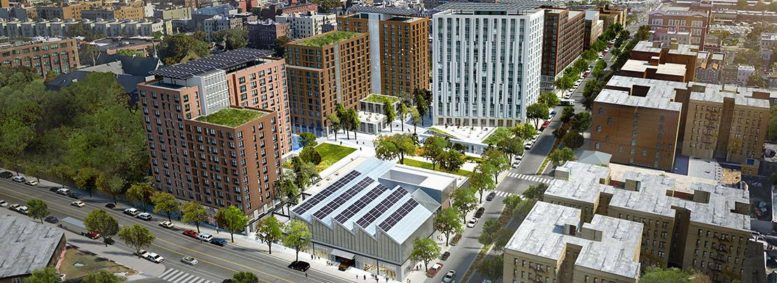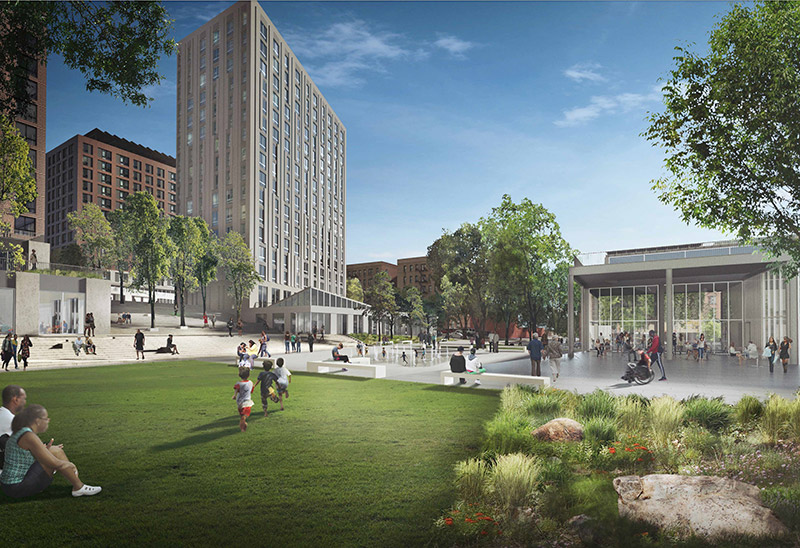Sets New York City on path to protecting Lower Manhattan from the deadly and costly effects of climate change
Mayor de Blasio, New York City Economic Development Corporation (NYCEDC) and the Mayor's Office of Climate Resiliency (MOCR) today released the Financial District and Seaport Climate Resilience Master Plan, a blueprint for comprehensive flood defense infrastructure to protect Lower Manhattan from the urgent threat of climate change. The plan, projected to cost $5 to $7 billion, reimagines the shoreline of Lower Manhattan and creates a resilient waterfront to withstand severe coastal storms and rising sea levels. Nearly one million people work in, live in, and commute through the low-lying Financial District and South Street Seaport neighborhoods. Illustrative images of the design proposal can be found here (credit: NYCEDC).
Protecting Lower Manhattan is imperative to New York City’s overall coastal resilience strategy. It is one of the nation’s largest central business districts, with half of workers coming from the outer boroughs; a critical hub of the subways and PATH transit systems and the regional highway network; and an iconic destination for millions of visitors from around the US and the world. Using the New York City Panel on Climate Change 90th percentile projections, by the 2050s rising tides are projected to flood the Financial District and Seaport monthly, then daily by the 2080s. Some level of frequent tidal flooding is likely to be seen as early as the 2040s.
“This Plan for a protected and resilient waterfront in Lower Manhattan will help us fully confront the urgent and accelerating threat of climate change,” said Mayor Bill de Blasio. “A recovery for all of us must ensure families, businesses, and communities in Lower Manhattan are able to withstand extreme weather and rising sea levels, which this vision guarantees.”
To protect the area, which was hard-hit by Hurricane Sandy in 2012, the master plan features a multilevel waterfront that extends the shoreline of the East River by up to 200 feet from its existing location. The upper level will be elevated by about 15 to 18 feet to protect against severe storms like Sandy, while doubling as public open spaces with sweeping views of the city and harbor. The lower level will be a continuous waterfront esplanade, raised three to five feet to protect against sea level rise while connecting New Yorkers to the water's edge. From now through 2100, if no action is taken, repetitive flooding is projected to cause up to $20 billion in estimated losses to the region. The master plan will safeguard Lower Manhattan in a time of rising sea levels and more frequent and intense coastal storms.
The master plan encompasses almost one mile of waterfront from The Battery to the Brooklyn Bridge. Notable features of the proposed plan include:
• Floodwalls buried in the landscape that create a line of ridges along this waterfront, permanently protecting Lower Manhattan from coastal storms and creating new open spaces with expansive views of the harbor
• Resilient stormwater infrastructure, including a new pump station along with green infrastructure
• Resilient ferry terminals for Staten Island, Governors Island, and NYC Ferries, among other operators
• Universally accessible entrances and pathways, designed to ensure people of all ages and abilities can get to and move around the waterfront
• New public open spaces with playgrounds, plazas, lawns, seating, and cafes
• Coves that promote habitat restoration and provide opportunities to learn about the ecology of the East River
• Resilient piers for docking historic ships, bolstering the historic character of South Street Seaport
The City has worked closely with the community to shape this plan. Through numerous public meetings and workshops, an online engagement portal, youth outreach with local schools, and other creative forms of engagement, the City incorporated feedback at every step along the way. To maximize outside input, the City also formed the Climate Coalition for Lower Manhattan, a group of local and citywide stakeholders chaired by Elizabeth Yee, Executive Vice President and Chief of Staff at The Rockefeller Foundation, and Tammy Meltzer, Chairperson of Manhattan Community Board 1.
“NYCEDC and MOCR have envisioned a 21st-Century resilient waterfront that stands to be a model for other major cities,” said NYCEDC President and CEO Rachel Loeb. “We’ve done years of work, and we have the innovation. There’s no doubt climate change is here. Sea levels are rising, and stronger, more devastating storms will only continue, which is why we must protect our coastline and safeguard our vulnerable historic Seaport area and Financial District. If we do not take action now residents, businesses, and critical infrastructure are put in jeopardy. We must rely on strong partnerships at all levels of government to help implement this plan.”
“The FiDi & Seaport Climate Resilience Master Plan provides the vision and blueprint for a resilient waterfront that can withstand the impacts of future coastal storms and sea level rise,” said Jainey Bavishi, Director of the Mayor’s Office of Climate Resiliency. ”The Master Plan is a product of years of collaboration between MOCR, NYCEDC, numerous City agencies, elected officials, technical experts and most importantly, community members. We must get to the work of implementation without delay.”
"New York City’s future depends on us planning for the effects of coastal storms and sea level rise in vulnerable places,” said NYC Parks Commissioner Gabrielle Fialkoff. “This new master plan outlines a vision for transforming the shoreline in the Financial District and Seaport that prioritizes the need for public access and climate planning along Lower Manhattan's waterfront.”
Next year, the City will move forward with the next phase of design and engineering needed to apply for federal funding and obtain required permits from state and federal regulatory agencies. With funding and prioritization by the regulatory agencies, comprehensive flood protection could be in place by 2035. In October, Mayor de Blasio announced $110 million in City funding for Seaport Coastal Resilience, a new project to protect South Street Seaport—the lowest lying and most vulnerable part of the master plan study area.
The master plan was led by NYCEDC and MOCR in partnership with a host of City agencies. Technical and design support was provided by an interdisciplinary consulting team led by the Dutch engineering firm Arcadis.
The Financial District and Seaport Climate Resilience Master Plan is part of the larger Lower Manhattan Coastal Resiliency (LMCR) strategy, backed by over $900 million in City investments to protect Lower Manhattan from flooding. This includes active capital projects in Battery Park City, The Battery, and the Two Bridges neighborhood north of the Brooklyn Bridge.













